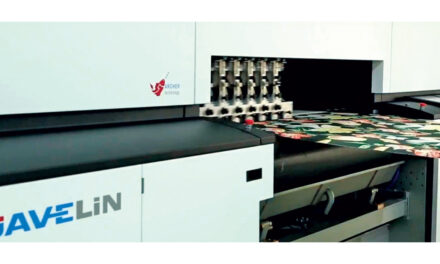When compared to 2016, there has been a 300 per cent growth in investments in Artificial Intelligence capabilities development in 2017 globally, as predicted by Forrester Research. An IDC research has predicted that the AI market will become worth more than $47 bn in 2020 growing from an $8 bn market in 2016.
We have seen science fictions portraying artificial intelligence as robots and near-human characters. But if you google the definition of AI, it says “programmes or systems that are designed to perform tasks requiring human intelligence: From visual perceptions, speech recognition, and language translations, decisionmaking to autonomous weapons.”
Further to my last article on factories of the future, which characterised artificial intelligence to be one of the biggest business disrupters in the coming decades? But, apparel industry needs to do more to harness this power to achieve profit-driven business.
AI, opposite to what is feared to be replacing people in the industry, can be used to embrace and create new opportunities. As far from reach as it sounds, AI is a part of our daily lives: From Siri to Google search engine, to self-driving cars, customer service chat boxes and much more.
Where can apparel industry adopt AI?
Due to its labour intensive nature, apparel industry can seek great benefits out of the AI intervention in their businesses.
Apparel retail
Apparel retail, specifically, e-commerce, is driven by the fashions trending globally. AI can help computers identify images and recommend those products online which the customer is more likely to buy. E-commerce and M-commerce platforms, through AI capabilities, are able to leverage the information available about the customers, and their inclinations, similarities, and differences in the kinds of applications and products they seek for. Hence, through AI we can actually create a personalised apparel shopping experience and hence derive more out of the retail than we are doing currently.
Such feedback could help product developers to plan their ranges but until they solve the dilemma of product fit, fit options and customer perception of size and designers intended ease over the body, a product or range success will still depend on ‘Getting It Market Right’ and probably eliminating the almost ‘Years Delay’ in the seasonal supply chain between idea and delivery, by which time last Springs Winners for your competitor may not repeat a year later for you, says industry expert, Frank Lomax.
Reinforcement learning
Apparel industry, specifically apparel manufacturing is a set of processes carried on repeatedly. AI here can be used for reinforcement learning which can be used to teach computers to take different actions based on the situational parameters that are the best possible for the optimal decisions in that situations. Thus, AI can be used in many processes like cutorder- planning, line balancing, inspection decisions, etc. Various decision-making software in the industry is already doing that. Apparel manufacturers can get real-time information based on the data input.
Reinforcement learning can also be used to automatically find the best possible cooling and operating configurations needed on the production floor, making them much more energy efficient.“The manufacturing environment in almost every process offers massive opportunities to extend and link and update existing systems using Artificial Intelligence from such as Product Data Management, Materials and Finished Product Stock Control, Product Manufacturing Data, General Sewing Data, Financial Control & Payroll to automatically forecast Constant Output Levels, Manning Levels, Skills Availability, Training Needs and Line Balancing.
However, there must be a point once the manufacturing process has begun where Constant AI Varying of Input data or instructions would need to be halted regardless of if it happening to be in the interest of says, the Retailer. For instance, sales data may be allowed to alter the Size and Quantity mix of the next Cut Order but not the basic product data in use on-line at the point of data change.
Many of these Intelligence Based Systems are utilised in the car industry to constantly forecast output and set the mandatory overtime levels needed by the factory to achieve the daily output target, while feeding back the same information to the component suppliers what their next 3 hour delivery batches will be, based on the very tightly controlled on-line work in process levels. Component suppliers who are dedicated and located within a short distance from the car factory and will compile the delivery of multiple options ready in sequence as the specific receiving cars move along the assembly line,” says Frank.
Communication
AI can help reduce the manual efforts required for communication via natural language processing and learning capabilities and help apparel businesses automate conversations with the buyers. Daily transaction conversation, customer/buyer support communication, and CRM communications: All can help the business transpire with zero error scope and personalised experience for the buyers.
Data analysis
Merchandising in the apparel industry is a functional area that has to deal with large volumes of data. AI intervention in merchandising can help the company to not just analyse large data volumes, but also predict consumer trends, making merchandising operation error free, and more aligned to the customer needs.
Apart from the capabilities discussed above, there is a sea of technologies that are already being offered by vendors like Amazon, Artificial solutions, Google, Creative virtual, Assist AI, etc. that apparel industry can use to improve its operating efficiency and gain cost advantages across the supply chain. Things like natural language generation, virtual agents, machine learning platforms, AI-optimized hardware, decision management, biometrics, robotic process automation…and the list goes on.
Are there any shortcomings in Artificial Intelligence?
While AI is progressing rapidly in every aspect of our lives and industrial operations, it comes with its own set of limitations which we cannot avoid:
- The biggest limitation that AI projects are of data safety, privacy, and control. “I would add to this Data Input Accuracy and Relevance to the Process. For instance, a simple Barcode Printing or reading error in store would feed in incorrect information,” says Frank.
- The cost of incorporating artificial intelligence in daily operations is still very high and further advancements in the technology might bring that down
- Above all, we are trying to replace human intelligence with a computer, which will take the time to develop, and will require a large set of information and scenarios to build decision-making tool optimally
“I would imagine that AI Developments and their proving will take Generations to Evolve and for businesses to grow as a direct result to carry the massive costs. Individuals Jobs, therefore, are likely to evolve and develop alongside over that time.
If AI were to be developed purely as a job reduction process it would fail. Job Costs per unit sold will reduce if product numbers sold increase. Every business which has decided to go down market and sell cheaper product soon learns a heavy lesson as it realises that they need to sell many more units just to create the same turnover, profit and Overhead Recovery,” explains Frank.
- AI interference in human roles can cost jobs for a considerable share of our manpower. Hence, critics might lobby against extended AI implementation.
Production management decision making is a skill based very much upon experience and with a comparably young workforce, the garment industry can utilise anything that “short circuits” the need for experience. AI can if integrated into the production management systems and structures provide such assistance.
Apparel industry expert Paul Collyer says, “However, in many garment production unit’s productivity and quality levels are restrained by the abilities of management. This manifest itself notably in planning for equipment, people, capacity planning, initial line balancing and very importantly on interpreting “real time” production data and intervening through effective decision making.
“While this all sound feasible, efficiencies of all types will be based on other factors which may aid or impede. Square Bags will produce higher materials utilisation if the Bag Size is calculated to use the Fabric Full Width where a multi part set of Graded Designer Dresses will not.
A commitment to a factory loading plan within pre-delivered fabrics and materials will improve factory utilisation even though it extends the product chain lead time and total inventory financing cost.AI can only aid the management of these examples, or maybe recommend not producing some of them leaving the supplier factory vulnerable to eventual under utilisation.
The complexities are enormous, however so is the Fly by Wire systems used to automatically control the flight of an Airbus Aircraft and that has already been achieved, says Frank.
Irrespective of the various shortcomings that AI poses in front of us today, implementing AI in our operations can help apparel industry to achieve much higher labour and material utilisation efficiencies, and thus control costs and grow profits. The actual impact of this technology will only be evident once we start moving on that path.
(Guest authors: Frank Lomax and Paul Collyer)



















